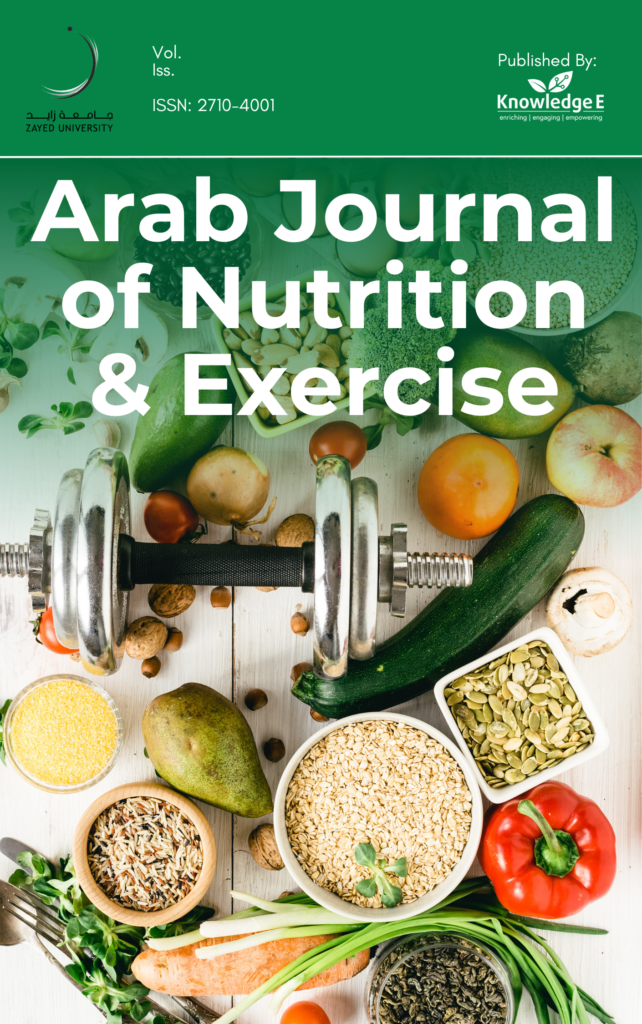
Arab Journal of Nutrition and Exercise
ISSN: 2518-6590
Groundbreaking research on nutrition, physical activity, and public health from across the Arab world.
Physical Activities of Young Girls in Jeddah, Saudi Arabia
Published date: Nov 12 2017
Journal Title: Arab Journal of Nutrition and Exercise
Issue title: AJNE: Vol 1, No 3 (2016)
Pages: 122-130
Authors:
Abstract:
Background: Physical education classes are non-existent in Saudi girls’ curriculum at all educational levels and physical activities are not permitted at public schools. The study aimed to assess physical activities for female students in intermediate and high schools.
Methods: A questionnaire was completed by 1519 participants from 18 schools in Jeddah City. Activities at school and after school were reported. About 63% of the girls preferred to have physical education classes at school.
Results: Girls thought that they were performing (43.2%) enough physical activities and (74%) rated themselves as performing an average level of physical activity in comparison with their peers. Only 32% linked the importance of physical activities to their health. Cars are the main transportation methods to and from school (87 %) and 8% walked to school. Some physical activities (59.2%) are performed at school [walking during break times (42%) or running (5.2%)]. Only 40% were involved in light activities after school while 54% participated in washing up or cleaning the house. Other activities outside school, e.g. walking, shopping, bowling, horse riding and table tennis was reported by 48% of the participants. Moderate activities such as swimming, cycling, dancing, or competitive running was reported by 70% of the respondents. Only 13% joining fitness centres.
Conclusion: Results emphasized the central role and obligation of decision makers in protecting young consumers through providing a healthy environment in schools.
References:
[1] M. Abou El-Ela, M. Soliman, and M. Amin, “Urban Waterfronts between Cultural and Physical Influences (The case of Jeddah and Alexandria) ,” in international sociaty of city and regional planning Conference - 43rd Isocarp Congress, Belgium, 2007.
[2] S. Al-Ghamdi, “The association between watching television and obesity in children of school-age in Saudi Arabia,” Journal of Family and Community Medicine (JFCM), vol.20, no. 2, p. 83, 2013.
[3] H. M. Al-Hazzaa, “Physical activity, fitness and fatness among Saudi children and adolescents: Implications for cardiovascular health,” Saudi Medical Journal, vol. 23, no. 2, pp. 144–150, 2002.
[4] H. M. Al-Hazzaa, N. A. Abahussain, H. I. Al-Sobayel, D. M. Qahwaji, and A. O. Musaiger, “Lifestyle factors associated with overweight and obesity among Saudi adolescents,” BMC Public Health, vol. 12, no. 1, article 354, 2012.
[5] E. Aljaaly, “Personal and Environmental Influences on Eating Behaviours of Adolescent Girls in Saudi Arabia,” in World Sustainable Development Outlook 2015 Green Behavior: Re-thinking Policy for Sustainability, 2015, ISBN: 978-1-907106-35-4; ISSN 1748-8133.
[6] E. Aljaaly, “Centralized fat status of adolescent girls in Saudi Arabia in comparison to the United Kingdom Reference Data,” British Journal of Medical and Health Research, vol. 1, no. 3, 2014.
[7] E. Al-Jaaly, M. Lawson, and T. Hesketh, “Overweight and its determinants in adolescent girls in Jeddah City, Saudi Arabia,” IJFNPH, vol. 4, no. 2, pp. 95–108, 2011.
[8] E. Al-Jaaly, Factors affecting nutritional status and eating behaviours of adolescent girls in Saudi Arabia [Ph.D. thesis], London, UK, UCL, 2012, http://discovery.ucl.
[9] B. A. Spear, “Adolescent growth and development.,” Journal of the Academy of Nutrition and Dietetics, vol. 102, no. 3, pp. S23–S29, 2002.
[10] V. Carson, S. Hunter, N. Kuzik et al., “Systematic review of sedentary behaviour and health indicators in school-aged children and youth: An update,” Applied Physiology, Nutrition, and Metabolism, vol. 41, no. 6, pp. S240–S265, 2016.
[11] F. M. Farahat, K. P. Joshi, and F. F. Al-Mazrou, “Assessment of nutritional status and lifestyle pattern among Saudi Arabian school children,” Saudi Medical Journal, vol. 28, no. 8, pp. 1298–1300, 2007.
[12] J. R. Fernández, D. T. Redden, A. Pietrobelli, and D. B. Allison, “Waist circumference percentiles in nationally representative samples of African-American, EuropeanAmerican, and Mexican-American children and adolescents,” Journal of Pediatrics, vol. 145, no. 4, pp. 439–444, 2004.
[13] D. Taha, O. Ahmed, and B. B. Sadiq, “The prevalence of metabolic syndrome and cardiovascular risk factors in a group of obese Saudi children and adolescents: A hospital-based study,” Annals of Saudi Medicine, vol. 29, no. 5, pp. 357–360, 2009.
[14] A. Musaiger, N. Zagzouk, and M. Almaaie, “The nutrition habits. Life style and obesity among adolescents in Jeddah city. Saudi Arabia (A comparison between governmental and private schools). ,” in The second conference of obesity, Bahrain, 2005, [Published paper in conference booklet].
[15] G. Smithers, C. J. Gregory Bates Jr, A. Prentice, L. V. Jackson, and R. Wenlock, “The National Diet and Nutrition,” The National Diet and Nutrition, 2000.
[16] D. Sellen, “Physical Status: The Use and Interpretation of Anthropometry. Report of a WHO Expert Committee. WHO Technical Report Series No. 854. Pp. 452. (WHO, Geneva, 1995.) Swiss Fr 71.00.,” Journal of Biosocial Science, vol. 30, no. 1, pp. 135–144.
[17] T. Armstrong and F. Bull, “Development of the World Health Organization Global Physical Activity Questionnaire (GPAQ),” Journal of Public Health, vol. 14, no. 2, pp. 66–70, 2006.
[18] T. Yates, E. G. Wilmot, and M. J. Davies, “Sedentary behaviour: Whats in a definition?” Am J Prev Med, vol. 40, pp. e33–10, 2011.